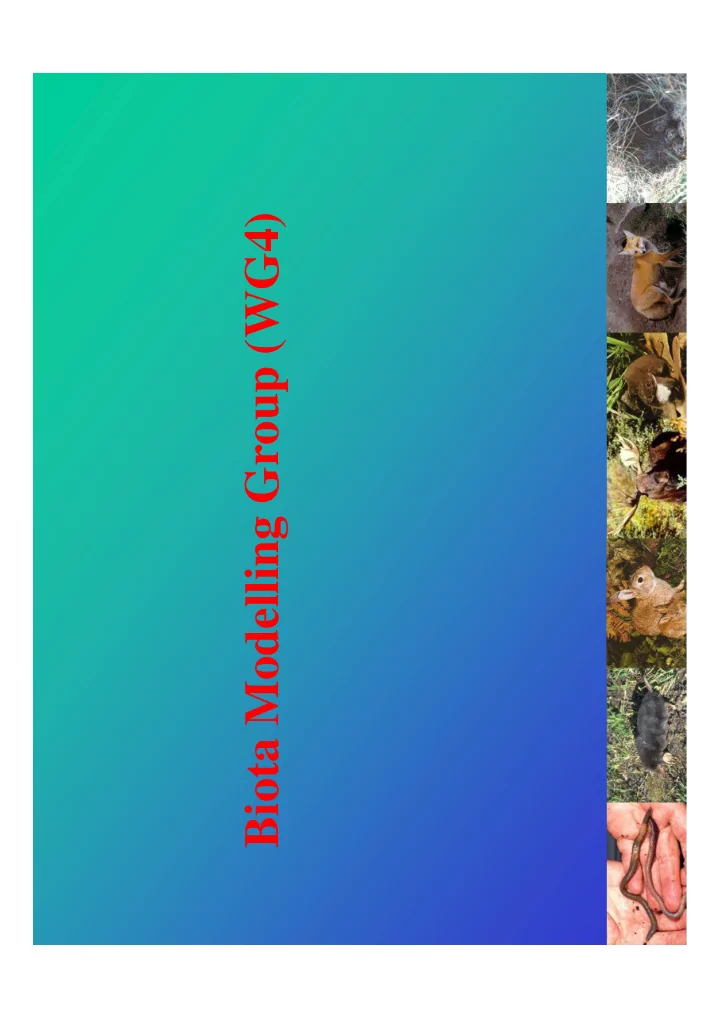

Biota Modelling Group (WG4)
Little Forest Burial Ground (ANSTO)
Site Location • Located near Sydney, New South Wales, Australia.
Waste Disposal • Waste disposed in 1960-68. • Waste was from reactor, medical, other academic research. • 79 trenches extending from ~1.0 to ~3.0 m below the ground surface. • ~150 GBq of radionuclides, including many short-lived isotopes as well as H-3, Co-60, Sr-90, Cs-137, Th-232, U-233, -235, -238, Pu-238/240, Am-241 among others • various forms and types of packaging.
1960-68 Disposal at LFBG
Present state •Grass-dominated vegetation cover, •Bordered by low forest & scrub representative of original vegetation. • Site is maintained with fencing, signage, grass mowing, and regular monitoring.
Plant – Grass Plant, tree – Acacia Plant, root crop – Yam Annelid – Earthworm Arthropods - Insects (grasshopper) Reptile – goanna Bird - raven Mammal, monotreme – Echidna Mammal, placental canine – Fox Mammal, marsupial macropod – Wallaby
Plant – Grass Plant, tree – Acacia Plant, root crop – Yam Annelid – Earthworm Arthropods - Insects (grasshopper) Reptile – goanna Participants Bird - raven SCK·CEN, Belgium Mammal, monotreme – Echidna CEH, UK ANL, USA Mammal, placental canine – Fox KAERI, Korea Jozef Stefan Institute, Slovenia Mammal, marsupial macropod – Wallaby NRPA, Norway Manchester Univ., UK
E RICA - CE H Fox - Concentration Ratios E RICA - SCK E RICA - JSI FASTE R-lite - NRP A 10 K-BIOTA - KAE RI 1 RE SRAD-BIOTA - ANL 0.1 0.01 0.001 0.0001 0.00001 7 2 8 9 1 0 0 4 8 3 3 3 3 3 3 4 -6 9 1 2 2 2 2 2 2 - o r - - S - - - - - m s h U U u u C C T P P A Fox - Tissue Concentrations (mean, 5th-95th percentiles) 1.E+04 1.E+03 1.E+02 1.E+01 1.E+00 1.E-01 g 1.E-02 K 1.E-03 / q B 1.E-04 1.E-05 1.E-06 1.E-07 1.E-08 Co-60 Sr-90 Cs-137 Th-232 U-234 U-238 Pu-238 Pu-239 Am-241 1.E-09 1.E-10 ERICA - CEH ERICA - SCK ERICA - JSI FASTER-lite - NRPA K-BIOTA - KAERI RESRAD-BIOTA - ANL RESRAD MDW Total dose (mean) & 5-95th percentiles Fox - Dose Estimates Internal dose (mean) E xternal dose (mean) 1.E-04 1.E-05 1.E-06 1.E-07 1.E-08 1.E-09 y 1.E-10 a d 1.E-11 / y G 1.E-12 1.E-13 1.E-14 1.E-15 Co-60 Sr-90 Cs-137 Th-232 U-234 U-238 Pu-238 Pu-239 Am-241 1.E-16 ERICA - CEH ERICA - SCK ERICA - JSI FASTER-lite - NRPA 1.E-17 K-BIOTA - KAERI RESRAD-BIOTA - ANL RESRAD MDW 1.E-18
E RICA - CE H Acacia - Concentration Ratios E RICA - SCK E RICA - JSI K-BIOTA - KAE RI 10 RE SRAD-BIOTA - ANL 1 RE SRAD MDW 0.1 Plant geometries - 0.01 0.001 0.0001 what are we trying to 0.00001 7 2 4 8 8 9 1 0 0 3 3 3 3 3 4 -6 r-9 3 -2 -2 -1 -2 -2 -2 -2 o S m C s h U U u u C T P P predict? A Acacia - Tissue Concentrations (mean, 5th-95th percentiles) 1.E+04 1.E+03 1.E+02 1.E+01 1.E+00 1.E-01 g K 1.E-02 / 1.E-03 q B 1.E-04 1.E-05 1.E-06 1.E-07 1.E-08 Co-60 Sr-90 Cs-137 Th-232 U-234 U-238 Pu-238 Pu-239 Am-241 1.E-09 1.E-10 ERICA - CEH -roots ERICA - SCK ERICA - JSI K-BIOTA - KAERI RESRAD-BIOTA - ANL RESRAD MDW ERICA CEH trunk Total dose (mean) & 5-95th percentiles Acacia - Dose Estimates Internal dose (mean) E xternal dose (mean) 1.E-04 1.E-05 1.E-06 1.E-07 1.E-08 1.E-09 y 1.E-10 a d 1.E-11 / y G 1.E-12 1.E-13 1.E-14 1.E-15 Co-60 Sr-90 Cs-137 Th-232 U-234 U-238 Pu-238 Pu-239 Am-241 1.E-16 ERICA - CEH ERICA - SCK ERICA - JSI K-BIOTA - KAERI 1.E-17 RESRAD-BIOTA - ANL RESRAD MDW ERICA CEH trunk 1.E-18
Canadian Nuclear Commission canadienne Safety Commission de sûreté nucléaire Beaverlodge uranium mine (CNSC)
Beaverlodge • Sediment, water & fish data available over a number of years [enables model-data comparison] – for U-238 series radionuclides • Reduced invertebrate populations/effects in fish/multi-contaminants (interaction with WG6) • Provide informed opinion on real issue
Scenario • Six Uranium Mining Facilities currently operating or decommissioned • Near Field: 7 • Far-field Sites: 5 • Reference: 3 • Species: 3 fish & 3 invertebrate species • Data available – mixed sediment, water, fish species (U-238, Th-230, Ra-226, Po-210, Pb-210) EMRAS II Meeting, Vienna, Austria 2011 01 24-28
Scenario • Six Uranium Mining Facilities currently Participants operating or decommissioned SCK·CEN, Belgium • Near Field: 7 CEH, UK EA, UK • Far-field Sites: 5 ANL, USA • Reference: 3 BARC, India IRSN, France • Species: 3 fish & 3 invertebrate species SUJB, Czech Republic • Data available – mixed sediment, water, CNSC, Canada fish species (U-238, Th-230, Ra-226, Po- KAERI, Korea Jozef Stefan Institute, Slovenia 210, Pb-210) EMRAS II Meeting, Vienna, Austria 2011 01 24-28
Considerable variability: Transfer parameter values K d Secular equilibrium assumptions How address missing input data
• Can we agree ‘best approach’ ? – Hopefully we did
Wetland scenario (SU, SSM) • Scenario derived from three wetlands in USA, Sweden and Canada • Range of organisms • How conduct ‘mixed’ ecosystem assessment • Test C-14 models • Scenario agreed – results for mid-term meeting
Dynamic modelling (?) • Assess the need and demand for dynamic models • Review available (adaptable) models • Achieved via questionnaire – To date 13 responses from regulators, industry, model developers/users – More responses requested by end Feb. 2011 (jvibatll@SCKCEN.BE or nab@ceh.ac.uk)
Dynamic modelling • Needed: no current approaches fit for purpose → yes for specific purposes • Availability of data to parameterise/validate? • Models developed for human foodchain assessment can be adapted for wildlife assessment • Guidance on what is required to adapt available (human) models
Recommend
More recommend